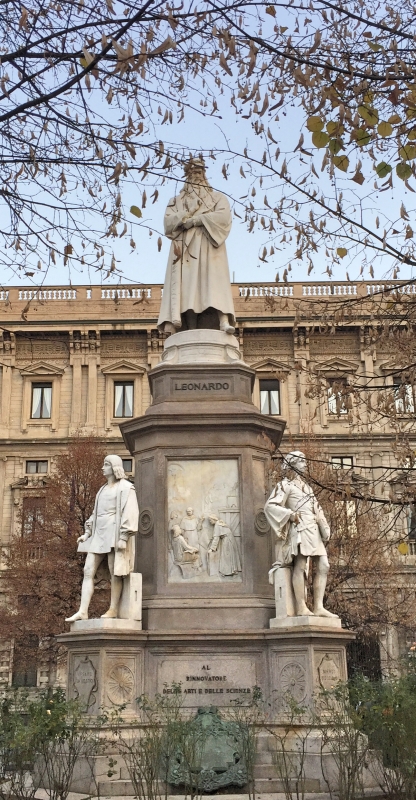
While Leonardo da Vinci lived in many different cities during his lifetime, one of his most famous works was created during his stay in Milan, when he painted the Last Supper in the refectory of the Santa Maria delle Grazie. He spent 17 years of working life in Milan.
In 1872, this monument was erected in honor of Leonardo da Vinci, considered one of the most multi-talented people to have ever walked on this planet. The monument, sculpted by Pietro Magni, shows Leonardo da Vinci standing on a large pedestal. His four favorite students are standing at the foot of the pedestal. The reliefs on the pedestal depict some of the disciplines that da Vinci mastered: painting, sculpting, engineering and architecture.
I think the monument not only narrates the great achievements that Da Vinci has achieved in different areas and depicts some of his famous works by the reliefs, but also narrates Da Vinci’s great influence on art, on other painters and his contribution to Renaissance. The four students can represent Da Vinci’s contribution to arts education and his great influence on his pupils.By this monument, I can feel that Italian are very proud of Da Vinci, not only proud of his achievement but are also proud that Italy was the birth place of Renaissance and the birth place of Da Vinci. The four reliefs show how genius that Da Vinci was. Usually his genius is consider to epitomise the Renaissance humanist ideal. Therefore, I think the monument was erected to display the humanist ideal in Renaissance period by showing Da Vinci’s genius. This monument not only reminds me Da Vinci’s achievement in multiple disciplines but also reminds me Italian achievement in Renaissance. I believe this monument can elicit Italians’ a sense of proud, the proud of their culture and the proud of their art history.
Front Side of the Monument
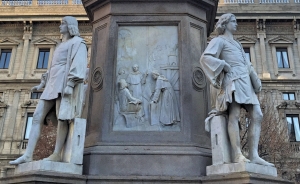
The relief depict one of the disciplines that Da Vinci mastered at: painting. It depicts Ludovico Sforza, who was was Duke of Milan from 1494 until 1499, is observing Leonardo’ Last supper.The student on the right hand side is Marco d’Oggiono. He was an Italian Renaissance painter and a chief pupil of Leonardo da Vinci.
Left Side of the Monument
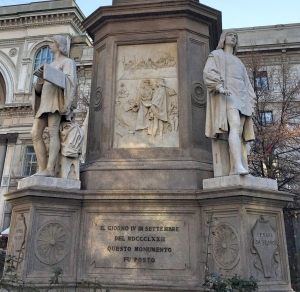
The relief depicts another disciplines that Da Vinci mastered at: engineering. It depicts Leonardo designs the sluices of the canals.The student on the right hand side is Cesare da Sesto (1477–1523). He was pupil of Da Vinci and was an Italian painter of the Renaissance. He mainly active in Milan. The carved characters on the marble pedestal indicates the year the monument is erected. The incription is “This monument is placed on the 4th of September of 1872”.
Back Side of the Monument
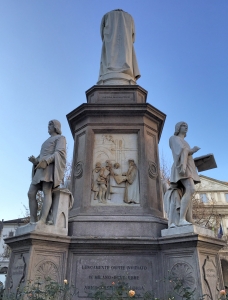
The relief shows another disciplines that Da Vinci was mastered at: architecture. The relief depicts Leonardo projects military buildings.The student on the right is Andrea Salaino. He was better known as Salaì and he painted under name of Andrea Salaino.
Right Side of the Monument
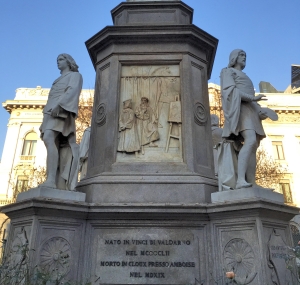
The relief describes another area that Da Vinci was mastered at : sculpture. The relief depicts Leonardo is showing Ludovico Sforza his sculpture of the “Sforza horse” (never completed)The student on the right hand side is Giovanni Antonio Boltraffio. Like Cesare da Sesto, Giovanni was an Italian painter of High Renaissance. He worked in the studio of Leonardo da Vinci and was considered as one of the strongest artistic personalities to emerge from Leonardo’s studio.
The carved character on the marble pedestal is the date of Da Vinci’s birth and death and the place of his birth and death.The inscription should be “born in Vinci, 1452; died in Cloux at Amboise, 1519”.
References:
http://www.aviewoncities.com/milan/piazzadellascala.htm
https://en.wikipedia.org/wiki/Marco_d%27Oggiono
https://commons.wikimedia.org/wiki/Category:Monument_to_Leonardo_da_Vinci_(Milan)
https://en.wikipedia.org/wiki/Cesare_da_Sesto